In every workplace, someone is responsible for the people inside. It could be a school where teachers are accountable for their classrooms, a manufacturing plant spread across thousands of square feet, or an admin building where people come and go throughout the day. Someone needs to know who’s where, so that if an earthquake, gas leak, or fire occurs, they can determine if everyone made it out safely. Occupancy tracking allows companies to do this with confidence.

What is Occupancy Tracking?
At its core, an occupancy tracking system monitors who is present in a defined area at any given time. The best systems provide real-time visibility into where people are, when they entered or exited the space, and whether they are staff, visitors, or contractors. But tracking people isn’t about a simple head count or surveillance. It’s about protecting people. Occupancy tracking systems provide peace of mind by enhancing safety, improving emergency response, and delivering operational benefits.
Benefits of Occupancy Tracking
Emergency Response
When accounting for people in an evacuation, you can’t afford to guess who’s still inside during a fire or chemical spill. Occupancy tracking is essential for any business or setting where danger can arise at any time.
Legal Compliance
Corporate or Government entities, as well as OSHA, can all require you to prove who is present and accounted for. While some regulations are light on specifics, having a system of knowing where people are when emergencies strike is paramount.
Operational Control
Occupancy tracking helps prevent overcrowding, reduce bottlenecks, and ensures secure or hazardous areas aren’t accessed by unauthorized personnel. It can also be leveraged to improve resource allocation. Heating, cooling, and lighting can all be adjusted based on actual occupancy, leading to efficient energy use and cost savings.
![]()
Effective Occupancy Tracking Systems
Physical Access Control Systems (PACS)
Badge readers, smartcards, and turnstiles log entry and exit data, forming the foundation for live occupancy lists. The software provides a clear view, so long as badges are swiped or scanned correctly and consistently.
Visitor Management Systems (VMS)
Where a physical access control system may only track regular employees, a visitor management system fills a gap in occupancy tracking by registering temporary personnel and their data into occupancy lists. VMS platforms log visitor check-ins and check-outs, issue temporary credentials, and often integrate with the access control system to help maintain a complete headcount of everyone on site.
Real-Time Location Systems (RTLS)
RTLS (using RFID, Wi-Fi, UWB, or BLE) enables precise tracking throughout a facility. Standard door readers tell you when someone entered a building, RTLS tells you they’re in Room 237 on the third floor. It works well in many cases, but can be expensive and infrastructure-heavy. Read more about what to consider when implementing RTLS here.
Mobile and Handheld Solutions
Handheld badge readers and mobile apps offer flexible, on-the-ground tracking where fixed devices can’t reach. Think of it like an access control system that goes beyond the doors. These can be used as an accessory or backup to an existing PACS or as a standalone solution. Handheld readers are ideal for temporary worksites, outdoor facilities, emergency mustering, and situations requiring rapid deployment.
Manual Tracking
Not every organization needs a digital solution. In many cases, a paper and pencil check-in system or a clipboard with a roster of names is sufficient for tracking occupancy. These simple, low-cost systems work well in environments like small classrooms, remote fieldwork, wilderness operations, or temporary job sites with limited digital infrastructure. However, relying on manual methods carries the risk of inaccuracies and human error.
How Does Occupancy Tracking Improve Emergency Response?
If there’s one moment occupancy tracking really proves its worth, it’s during an emergency evacuation. Imagine alarms going off, people scattered across buildings, some deep in machinery, others outdoors or underground. In these situations, the occupancy system assists safety managers by providing a roster to account for who is safe or missing. RTLS or mobile options can speed up the roll call process. Integrated handheld devices retrieve live occupancy information from the PACS, allowing safety personnel or first responders to view identities and last known locations immediately.
One compelling example comes from a wildfire evacuation at a Canadian oil refinery. Their manual process previously took hours to account for everyone. After switching to a mobile mustering solution, the refiner was able to track personnel even after relocating the muster point five miles away. Access to live occupancy data significantly improved the speed and accuracy of their response.
Other Real-Life Use Cases
Occupancy tracking isn’t limited to one industry. Settings such as restaurants, concert venues, and sports arenas all use some form of it to manage crowds and ensure safety. In the workplace, it’s just as critical. Here are a few environments where tracking who’s on-site is essential for safety and operational control:
- Manufacturing Environments: With rotating shifts, confined spaces, and live machinery, tracking who’s on-site and where they are is critical for safety.
- Large Office Campuses: Especially with hybrid workforces, digital check-ins provide visibility into who’s present across multiple buildings.
- Remote or Temporary Worksites: Where there is no fixed infrastructure, solutions that can be deployed quickly are ideal.
- Schools & Educational Institutions: There are a number of different reasons for tracking student occupancy, including daily attendance, emergency drills, contact tracing, bus coordination, or lunch tracking.
- Hazard Zones: In places where people are exposed to real risks, such as working inside a mine or around dangerous chemicals, even a simple sheet on the wall showing who’s in and out can be a lifesaver.
Occupancy Tracking Best Practices for Safety Teams
Tips for Success
- Consider using digital accountability systems to accelerate and reduce errors during drills and real emergencies. However, if using an online system, ensure it works offline or have a backup plan in case network connectivity is lost.
- Train staff on both digital and manual backup procedures. No matter the system, it requires consistency, training, and a designated person to maintain it.
- Regularly audit systems for efficiency and reliability. Are there gaps in the process? Emergencies are unpredictable, and when it comes to safety, businesses can’t be complacent.
Integration Is Everything
Occupancy tracking works best when your systems are integrated. A tool like Telaeris’ XPressEntry provides handheld mustering and entry/exit tracking, integrating with LenelS2, Genetec, AMAG, and over 40 other systems. The best solution adapts to your facility layout without compromising data privacy and security needs.
The Bottom Line
Companies that care about their people use occupancy tracking to keep them protected and accounted for. This requires a system that’s reliable, efficient, and ideal for the work environment. As digital solutions advance, expect tighter integrations with existing systems, increased automation, and more intelligent dashboards displaying real-time data.
About Telaeris
If your current system relies on crossed fingers and clipboards, it might be time to upgrade. At Telaeris, we’ve helped security and safety teams around the world solve challenges in emergency mustering and personnel tracking. Our handheld badge readers are built for anything – rugged, flexible, and integrated with leading access control systems. CONTACT US to learn how our solutions can help your team.



